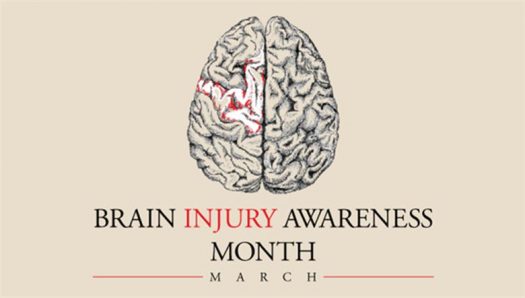By: Kalin Goble, MS
I was out this weekend having dinner with a close friend. While waiting for food and listening to the band, she told me that her childhood best friend had experienced mild traumatic brain injury (TBI). I listened to her share the struggles her friend was facing, as a young, outgoing 30-year-old now dealing with unexpected challenges and major lifestyle barriers. Even putting on shoes had become a strenuous task. From experiencing shifts in moods and behavior to difficulty with physical activity, everyday life was being reshaped.
The brain is the powerhouse for all we do, say, think, and feel. When the brain sustains an injury, every aspect of one’s life may be impacted. And the possibility of sustaining a TBI is increased for military service members in comparison to their civilian contemporaries. The Defense and Veterans Brain Injury Center found that over 413,858 service members have been diagnosed with some form of TBI from 2000-2019.
March is National Brain Injury Awareness Month and we wanted to observe this topic which is so prevalent to the military service population, by providing resources for those impacted by TBI.
The National Institute of Neurological Disorders and Stroke (NINDS) defines a Traumatic Brain Injury as a form of acquired brain injury. These injuries occur when a sudden trauma causes damage to the brain. According to BrainLine, someone sustains a brain injury every 9 seconds in the United States. This adds up to about 3.5 million people in the US facing some form of a brain injury each year. Brain injuries can range from mild to severe. The impacts and symptoms of TBI are just as wide ranging, and each person affected by TBI faces a unique set of symptoms and challenges. Below are resources for patients, caregivers, and health professionals that help explain and offer treatment ideas for the various forms of traumatic brain injury.
Defense and Veterans Brain Injury Center
The Defense and Veterans Brain Injury Center (DVBIC) is a part of the U.S. Military Health System and offers online and in-person care and treatment for those within the Military Health Care System (MHS). DVBIC offers resources pertaining to:
- blast injuries
- returning to duty
- experiencing multiple cumulative concussions
- concussion screening information
- and strategies for managing TBI
Clinical tools and patient education fact sheets are available to download from dvbic.dcoe.mil/resources. This site has a link to the Department of Veterans Affairs Military & Veterans Crisis Line, which connects veterans to qualified Department of Veteran Affairs responders 24/7 and at no cost. The number to the Crisis Line is 800-273-8255 (Dial and Press 1).
The National Institute of Neurological Disorders and Stroke
The National Institute of Health aims to seek fundamental knowledge about the brain and nervous system. Their goal is to help reduce the hardships of neurological disease. The NIH has a comprehensive guide to understanding Traumatic Brain Injury. It includes information on all things TBI including how the brain is affected as well as prevention strategies. Resources on neurological disorders and common terms associated with TBI are also included. Get a printable PDF or visit www.ninds.nih.gov
The BrainLine Project
BrainLine is a national multimedia project providing resources, information, and support to those affected by brain injury or PTSD. They help the individuals themselves, their caregivers, families and friends, and the service professionals working with them. BrainLine offers military-specific resources for service members, veterans, and their families. They have a section of resources and information dedicated to military-specific situations of TBI and PTSD. The topics covered include:
- strategies for managing symptoms
- information and resources for those returning to school and/or work
- information for military caregivers
- personal stories and blog posts from military service personnel that have sustained some form of brain injury
The Brainline website at www.brainline.org also includes a Military Resource Directory listing local resources based on your state and location.
Additional OneOp Resources Focusing on this Topic Include:
(Blog post) Resource Discovery| The Defense and Veteran Brain Injury Center (DVBIC) and “A Head for the Future”
- This Resource Discovery blog post further highlights the Defense and Veterans Brain Injury Center (DVBIC) and their initiative “A Head for the Future.” This initiative provides resources to the larger military community and includes resources on prevention efforts, ways to recognize the consequences of TBI, and information on recovering from a TBI.
(Blog post) Taken for Granted: The Effect of Traumatic Brain Injury on Sense of Identity and Family Relationships
- This blog post delves into the impact of TBI on one’s sense of self. It also discusses the impact on sustaining a brain injury has on the family structure.
(Blog post) Deep Impact: Traumatic Brain Injury (TBI) and the Family
- This blog post covers the wide array of signs and symptoms someone sustaining a TBI may present by looking at the story of Chief Petty Officer Brian O’Rourke. His journey with TBI demonstrates the uniqueness of TBI and the experiences of those dealing with brain injury.
(Webinar) Gray Matters: Understanding Traumatic Brain Injury’s Impact on Families
- This archived webinar provides a basic awareness of Traumatic Brain Injury and its potential impact on daily life including work, family, and relationships. Presenter Heidi Knock, PsyD, HSPP, covers signs, symptoms, and helpful interventions when working with individuals and families dealing with TBI. CE credits are no longer available for this training session.
References
[2] National Institute of Neurological Disorders and Stroke (2019). Traumatic Brain injury Information Page. Retrieved from: https://www.ninds.nih.gov/Disorders/All-Disorders/Traumatic-Brain-Injury-Information-Page
[3] Brain line (2020). All About Brain Injury and PTSD. Retrieved from: https://www.brainline.org/
[4] Defense and Veteran Brain Injury Center (2020). Resources. Retrieved from: https://dvbic.dcoe.mil/resources
[5] National Institute of Neurological Disorders and Stroke (2019). Traumatic Brain Injury: Hope Through Research. Retrieved from: https://www.ninds.nih.gov/Disorders/Patient-Caregiver-Education/Hope-Through-Research/Traumatic-Brain-Injury-Hope-Through
Blog Image: US Air Force [Brain Injury Awareness Month by Robin Meredith, March 11, 2015, CC0]













